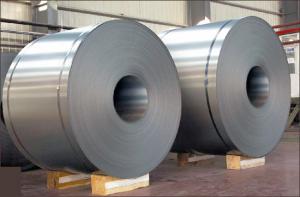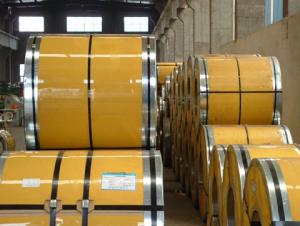Hot Dip Galvanized Steel Coil-Regular Spangle
- Loading Port:
- Tianjin Port
- Payment Terms:
- TT or LC
- Min Order Qty:
- 50mt m.t.
- Supply Capability:
- 5000 tons per month m.t./month
OKorder Service Pledge
OKorder Financial Service
You Might Also Like
Hot Dip Galvanized Steel Coil-Regular Spangle
Hot-dip galvanized steel coils are available with a pure zinc coating through the hot-dip galvanizing process. It offers the economy, strength and formability of steel combined with the corrosion resistance of zinc. The hot-dip process is the process by which steel gets coated in layers of zinc to protect against rust. It is especially useful for countless outdoor and industrial applications.
Product Description Of Hot Dip Galvanized Steel Coil-Regular Spangle
|
Thickness |
0.13mm-0.7mm |
|
Width |
600mm-1250mm |
|
Zinc Coating |
30-200g/m2 |
|
Internal Diameter |
508mm/610mm |
|
Coil Weight |
3-12MT |
|
Quality |
commercial and structural quality |
|
Surface Treatment |
regular & minimum spangle, zero spangle, oiled & dry, chromated , non-skin pass , skin pass |
|
Standard |
JIS G 3302, ASTM A 653M, EN 10327 |
|
Steel Grade |
SGCC, CS, FS, SS, LFQ, DX51D+Z , S280GD |
Technical Data Of Hot Dip Galvanized Steel Coil-Regular Spangle
|
Chemical Composition |
C |
Si |
Mn |
P |
S |
|
0.04-0.06% |
0.01-0.03% |
0.18-0.22% |
0.014-0.016% |
0.006%-0.009% |
|
Yield Strength |
(Mpa) 280-320 |
|
Tensile Strength |
(Mpa) 340-390 |
|
Elongation |
20%-30% |
|
Out-of-square |
not exceed 1% Flatness |
|
Bow |
15mmmax |
|
Edge Wave |
9mmmax |
|
Centre Buckle |
8mmmax |
|
Bending At 180 Degree |
No crack, purling and fraction |
Application Of Hot Dip Galvanized Steel Coil-Regular Spangle
It can be widely used in transportation, light industry, civil usage and farming. It is also the perfect building material in construction for making roofing tile, steel profiles for wall partition, T-bar, studs, fireproof door, air conditioning duct and home appliance.
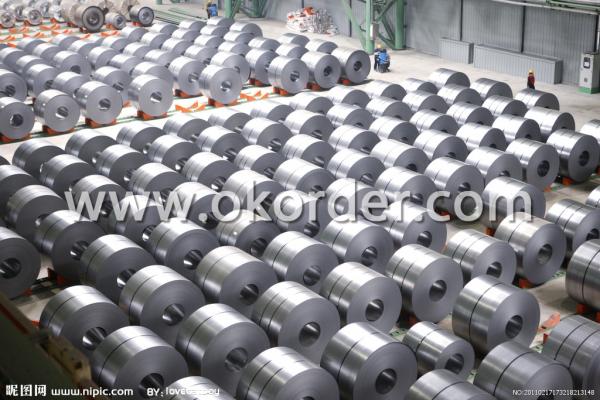
Packaging & Delivery Of Hot Dip Galvanized Steel Coil-Regular Spangle
The packing of coils consists of anti-damp paper, PVC film, hardboard paper, steel box, strapped with steel strips, fitted with locks and edge protectors and guarantees the optimal condition of the delivered goods. Each coil can be additionally fitted with wooden/steel skids(eye to the side) or wooden pallets(eye to the sky).
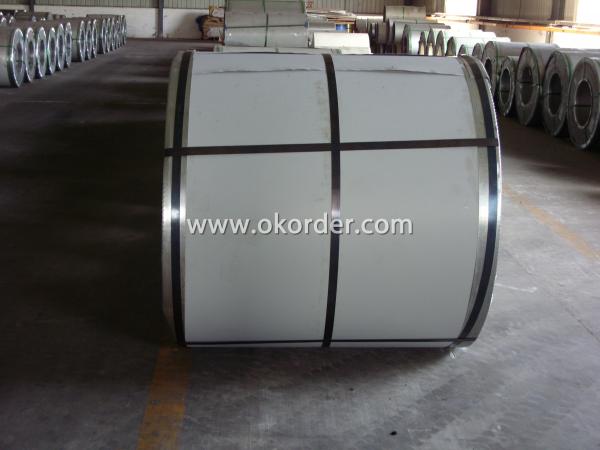
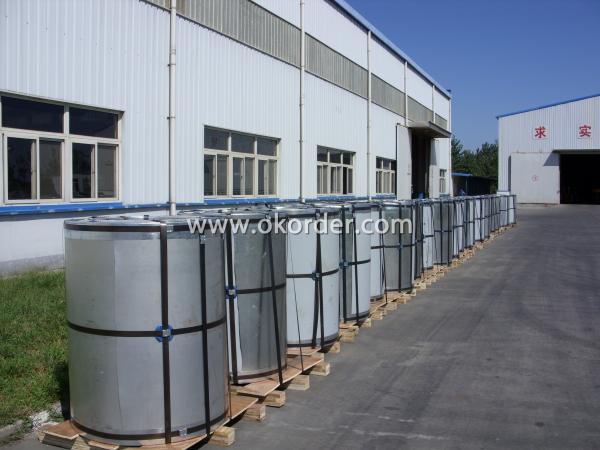
Production Flow Of Hot Dip Galvanized Steel Coil-Regular Spangle
Production flow of hot dip galvanized steel coil - zero spangle - forward - 30 - 200g/m2 include dual uncoiler, stitcher(welder), bridle, steering unit, entry accumulator, heating & soaking furnace, jet cooling section, ceramic zinc port, cooling tower, skin pass mill, tension leveller, chromating with dryer, exit accumulator and dual recoiler.
- Q:What are the different types of steel coil slitting blades?
- There are several different types of steel coil slitting blades, including circular slitting blades, crush cut slitting blades, and razor slitting blades. Each type has its own unique design and is used for specific applications in the steel coil slitting process. Circular slitting blades are commonly used for high-speed slitting and provide precise and smooth cuts. Crush cut slitting blades are designed to crush and shear the material, making them suitable for cutting delicate or fragile materials. Razor slitting blades have a sharp edge that slices through the material, making them ideal for thicker or tougher materials. Overall, the choice of blade type depends on the specific requirements of the slitting process and the type of material being cut.
- Q:How are steel coils inspected for chemical composition?
- The chemical composition of steel coils is examined using spectroscopy, a process that involves the utilization of a spectrometer. This instrument analyzes the light emitted or absorbed by a sample to determine its chemical makeup. Normally, a small portion of the coil is taken and prepared for analysis in the case of steel coils. This portion is then placed in the spectrometer, where a beam of light is emitted onto it. The light interacts with the atoms and molecules in the sample, causing specific wavelengths of light to be emitted or absorbed. The spectrometer measures the intensity of the emitted or absorbed light at different wavelengths and generates a spectrum, which is essentially a distinct fingerprint for the sample. This spectrum is then compared to a database of known spectra for various elements and compounds to ascertain the chemical composition of the steel. Through spectroscopic analysis, the presence and concentration of different elements like carbon, manganese, phosphorus, sulfur, and other trace elements in the steel can be identified. These elements have a significant impact on the steel's properties, strength, and suitability for different applications. Ensuring that the steel complies with the required specifications and standards, inspection for chemical composition is crucial in the steel industry. Any deviation from the desired chemical composition can potentially compromise the steel's performance and result in structural failures or other defects. In conclusion, spectroscopy offers a highly precise and dependable method for examining the chemical composition of steel coils. This aids in maintaining the quality and integrity of the steel products.
- Q:I know there is soft steel and sturdier steel they use in products. The sturdier often used for equipment that requires more durability when in operation.
- Some steel won't 'harden' very much to begin with. Mild steel found commonly around the shop/farm/house has few alloys other than carbon, and may not get the desired hardness no matter what you do. A quick test to see what type you have (mild steel vs. alloy) is to touch it to a grinding wheel.
- Q:Edward Humphrey wants to know... Can I use steel roofing on an older house?
- ed like others have said yes you can and its relatively simple to do. ? is it steal you want or would to plastic they call it work. we've done several around here in central Illinois and we've done both. as far as putting boards under the metal we've only done that on one, usally you start at a bottom corner, work your way across the roof and up just as you do shingles, remember though unlike shingles these don't have any sealing strips, so under each overlap before putting the piece on you need to put a sealer bead on. the tubes from your local lumber yard work just fine. just remember dont hurry yourself into making mistakes and forgetting anything. i don't know if you have helpers but generally you can hire a high school kid to help put this on. it isn't really that hard.use whats called a barn screw to hold it onto your existing roof,( they are color coated, and have rubber gaskets) so no leaks where fastened unlike nails.
- Q:What are the advantages of using steel coils in the manufacturing industry?
- There are several advantages of using steel coils in the manufacturing industry. Firstly, steel coils provide excellent strength and durability, making them ideal for applications that require high load-bearing capacity. Secondly, steel coils are highly resistant to corrosion, making them suitable for outdoor or harsh environments. Additionally, steel coils offer consistent and uniform properties, ensuring reliable and precise manufacturing processes. Moreover, steel coils can be easily formed and shaped, allowing for versatile use in various industries. Lastly, steel coils are recyclable, making them an environmentally friendly choice.
- Q:I have a knife with AUS8 Stainless Steel. No idea what that means. I want to know some of the best stainless steels for knifes and all you can tell me about stainless steel would be great. I was browsing google and looking at grades and had no idea what all the numbers meant. Thanks!
- I do engraving on knife blades (actually all kinds of metal but occasionally knife blades). Every company's blades are a little different. I get the idea that different companies have different compounds. All the materials are some compromise between hardness, toughness, corrosion resistance, machineability and other considerations. Stainless is generally not as good as a high-carbon steel, but high-carbon steel rusts and turns black. Stainless is much easier to keep clean.
- Q:I am currently writing a manuscript, and would like to know whether guns made out of steel, burn or melt when exposed to flames. Thanks.
- Steel guns would be very hard to melt, and impossible to burn, in any circumstances you could reasonably expect them to encounter at least. If you expose them to a flame they'll just get carbon on them from the flame, turning them black...
- Q:What is the lifespan of coated steel coils?
- The lifespan of coated steel coils may differ based on various factors, including the coating type and quality, the environmental conditions they face, and the care and maintenance provided. Typically, high-quality coated steel coils can last 25 to 50 years or longer. However, it is important to note that this estimate is not definitive and the actual lifespan may vary. To significantly extend the lifespan of coated steel coils, it is essential to conduct regular inspections, ensure proper installation, and perform timely maintenance. Moreover, exposure to severe weather, corrosive environments, and improper handling can potentially shorten the lifespan. Consulting with manufacturers or industry experts is recommended to determine the most suitable coating and expected lifespan for specific applications.
- Q:Steel or stainless steel
- Steel often has impurities that can generate fumes, which cause a fever identical to smoke inhalation. You always need to be concerned about what you are breathing around hot metal.
- Q:Can someone help me...i have a diagram and were supposed to calculate the steel tonnage needed for the pictre. Can someone tell me step by step what i need to do (ex:find area of ...)
- - Find the cross sectional area of the steel bars if given, if not find the volume of concrete and approximately multiply the concrete volume by 400kg the weight of steel per concrete volume. - If you find the steel cross sectional area , multiply by the
1. Manufacturer Overview |
|
|---|---|
| Location | Shandong, China |
| Year Established | 2010 |
| Annual Output Value | |
| Main Markets | 33.03% Southeast Asia 33.03% South America 20.18% Africa 13.76% Mid East |
| Company Certifications | ISO9001:2008 |
2. Manufacturer Certificates |
|
|---|---|
| a) Certification Name | |
| Range | |
| Reference | |
| Validity Period | |
3. Manufacturer Capability |
|
|---|---|
| a)Trade Capacity | |
| Nearest Port | Tianjin Port, China |
| Export Percentage | 61% - 70% |
| No.of Employees in Trade Department | Above 100 People |
| Language Spoken: | Chinese, English |
| b)Factory Information | |
| Factory Size: | 10,000-30,000 square meters |
| No. of Production Lines | 10 |
| Contract Manufacturing | OEM Service Offered |
| Product Price Range | Low |
Send your message to us
Hot Dip Galvanized Steel Coil-Regular Spangle
- Loading Port:
- Tianjin Port
- Payment Terms:
- TT or LC
- Min Order Qty:
- 50mt m.t.
- Supply Capability:
- 5000 tons per month m.t./month
OKorder Service Pledge
OKorder Financial Service
Similar products
New products
Hot products
Related keywords

